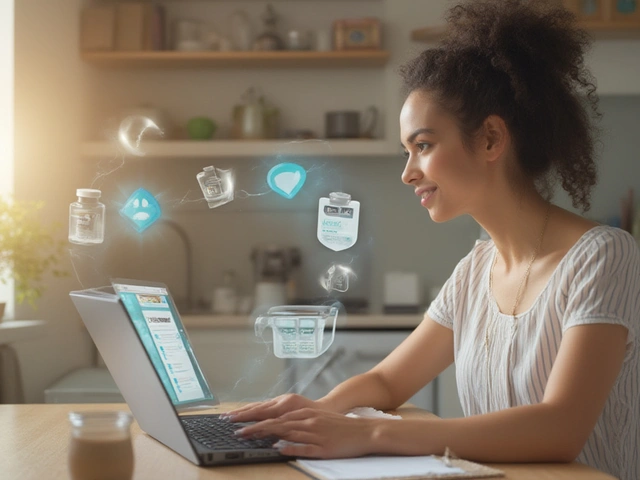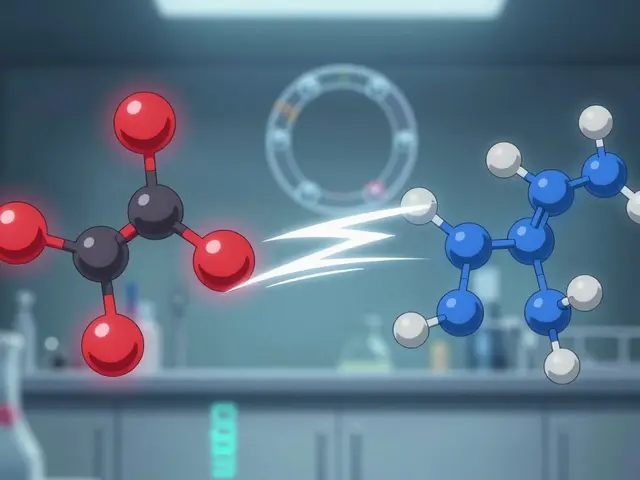
Health July 6, 2025
Benzoyl Peroxide in Hormonal Acne: Clearer Skin with Science-Backed Results
So, you wake up with yet another spot, right there on your chin or jaw. Sound familiar? That's hormonal acne, and it’s no stranger to people in their twenties, thirties, or honestly, anyone with unpredictable hormones. Maybe you’ve already scrolled past a dozen TikToks promising miracle cures, but one little white tube keeps popping up in the comments: benzoyl peroxide. Let’s figure out what all the fuss is about.
Understanding Hormonal Acne: More Than Just a Pimple
If you thought acne was just a teenage drama, hormonal acne loves making an appearance in adulthood too. It typically pops up in areas like the jawline, chin, and cheeks and is strongly connected to monthly hormonal swings, stress, or underlying conditions like PCOS. Studies published by the British Journal of Dermatology have shown that around 50% of women in their twenties still deal with acne, largely due to these hormonal rollercoasters.
What’s so frustrating about hormonal acne is that it doesn’t often respond to the usual facelift of cleansers or toners found in teenage skincare aisles. This type usually starts deep under the skin, forming those tender, under-the-skin nodules and cysts that aren’t easily squeezed (and please, don’t try—your skin will remember). Unlike the whiteheads and blackheads you might have picked in your teens, hormonal acne is more stubborn and sometimes painful.
Let’s face it, managing hormonal acne is a marathon, not a sprint. But there’s hope: knowing why it forms puts you in a better place to treat it. The real culprit is a cocktail of oil overproduction, clogged pores, and—yep—hormonal androgens ramping things up around your jaw and mouth. That’s where targeted treatments come into play. Enter benzoyl peroxide.
Benzoyl Peroxide: Your Skincare Ally Explained
Benzoyl peroxide sounds like something a chemist would splash on a beaker, but it’s been a staple in dermatology clinics since the 1930s. Its big claim to fame? It battles the bacteria that fuel most acne, specifically Cutibacterium acnes (previously Propionibacterium acnes). This bacteria thrives in oil-rich environments—like those blocked pores that hormonal acne loves.
But benzoyl peroxide isn’t just about surface-level cleansing. Once applied, it releases oxygen, which acne bacteria absolutely hate—it can’t survive in an oxygen-rich space. So, benzoyl peroxide makes your skin an unwelcome host for those pesky invaders. Even better, it helps shed dead skin and dries up excess oil, reducing the stubborn swelling of hormonal spots.
Here’s a fun fact: Studies published in 2023 in Clinical, Cosmetic and Investigational Dermatology found that benzoyl peroxide starts working within a few days, slashing visible acne bacteria by more than 90%. That’s faster than a lot of prescription creams. No wonder dermatologists in the UK and worldwide recommend it, often as a first-line over-the-counter treatment.
You’ll see this ingredient in everything from face washes to leave-on gels. It’s usually available in 2.5%, 5%, and 10% strengths in high street shops like Boots or Superdrug. Dermatologists usually suggest starting lower to keep irritation down while your skin adapts.

How Benzoyl Peroxide Tackles Hormonal Acne
Benzoyl peroxide does a lot, but how does it stand up to the mood-swinging, deep-seated drama of hormonal acne? Here’s the inside scoop.
First, the deep cysts and nodules of hormonal acne often resist the quick wins you get from basic spot treatments. That’s why a consistent routine is key. Benzoyl peroxide can’t rebalance your hormones (let’s not get carried away!) but it does lower inflammation, unclog pores, and kill the acne bacteria that inflame these deeper spots.
Most people start seeing change after two-four weeks of regular use, and the real magic happens when you give it at least 6-8 weeks. Studies show that applying benzoyl peroxide daily at night works best, particularly when blended with gentle routines that won’t dry you out further. The British Association of Dermatologists recommends pairing benzoyl peroxide with topical retinoids for these stubborn cases, but always one after the other, not mixed together, or you’ll be left with serious irritation.
Unlike antibiotics, benzoyl peroxide doesn’t cause resistance, so you won’t have your skin outsmarting your treatment over time. That’s a huge reason it’s still a first pick for many people battling hormonal acne. Some real-world tips:
- Always apply to clean, dry skin—wet skin can draw the product deeper and cause stinging.
- Start with a pin-head size and work up as your skin gets used to it.
- Let it sink in before layering moisturiser on top—it’s less drying that way.
- Avoid the mistake of slathering it everywhere. Focus on acne-prone areas.
- Watch out for bleached towels or pillowcases. Benzoyl peroxide loves to leave a mark!
Making Benzoyl Peroxide Work For You: Practical Tips
Want to know the secret sauce for using benzoyl peroxide so you get results and not just flaky patches everywhere? Treat it like the potent tool it is. Set some healthy skin boundaries, and you’ll see better results.
Go slow. You wouldn’t decide to run a marathon without a few practice jogs. The same goes for your skin. For the first week, apply benzoyl peroxide every other night. If your face isn’t panicking, move to nightly. As your skin builds tolerance, it’ll get better at handling it.
Less is more. Slathering thick layers won’t speed things up—it’s more likely to send your skin into meltdown mode. A pea-sized amount is plenty for the whole chin and jaw. Spread it gently, wait a minute or two, then moisturise.
Use a mild cleanser. Avoid harsh scrubbing and acids when starting out. Your skin is already adapting, and overdoing it only strips away natural protection. The classic CeraVe Hydrating Cleanser or La Roche-Posay Toleriane Dermo-Cleanser are great choices. They’re easy to find at Boots, and even sensitive skin types swear by them.
Wear SPF every day. Benzoyl peroxide makes your skin a bit more sun-sensitive. Get in the habit of using at least SPF 30 in the mornings. There’s zero point treating acne if you swap it for hyperpigmentation.
Watch for warning signs. If your skin goes from a little pink to full-on burning or blistering, lay off and let it recover. You can always test again, just slower next time.
Here’s something that surprises people: water-based benzoyl peroxide gels are less pore-clogging, so if your skin is freaked out by thick creams, look for one labelled as "gel". Never use it right after exfoliating or waxing, or on sunburnt skin. Bad move.
- Dab, don’t rub. Patting the product gives you better coverage and is gentler.
- If using other acne creams (like retinoids or salicylic acid), alternate nights to avoid irritation.
- Keep a spare pillowcase—no one enjoys white bleach marks.
- Be patient. Consistency, not intensity, gets real results.

Benzoyl Peroxide vs. Other Treatments: Which Wins for Hormonal Acne?
Here’s where things get interesting. There are dozens of acne treatments out there, and everyone’s skin tells a different story. Hormonal acne is especially stubborn, so it’s rarely a one-size-fits-all situation.
How does benzoyl peroxide rank against the competition?
| Treatment | Best For | Time to See Results | Main Drawbacks |
|---|---|---|---|
| benzoyl peroxide | Bacterial acne, inflamed spots | 2-6 weeks | Dryness, bleaching fabrics |
| Topical retinoids (adapalene, tretinoin) | Blocked pores, blackheads | 4-12 weeks | Dryness, irritation |
| Oral contraceptives | Hormonal acne, females | 2-3 months | Individual hormonal risks |
| Spironolactone | Severe hormonal acne, females | 2-3 months | Prescription-only, side effects |
| Antibiotics (topical/oral) | Inflamed, severe acne | 1-2 months | Resistance risk, gut issues |
| Salicylic acid | Blocked pores, mild acne | 1-2 months | Irritation if overused |
Benzoyl peroxide stands out for being accessible (you can buy it over the counter), safe in the long-term, and especially good at lowering surface-level inflammation. But, if your hormonal acne is deeply rooted and won’t budge, sometimes your GP might suggest adding prescription treatments that get hormones under control from the inside.
If you’re clever about it, combining approaches can be a winning strategy. For example, a gentle retinoid at night with benzoyl peroxide on alternate nights often does wonders. Or using benzoyl peroxide in the morning, retinoid at night, always with a moisturiser and SPF.
- Talk to a GP or dermatologist for deep, cystic, or scarring acne.
- Don’t jump between products every week; give each at least two months.
- If you experience mood changes or sudden health shifts, especially with hormonal meds, seek professional advice.
Write a comment
Items marked with * are required.






10 Comments
M Black July 10, 2025 AT 00:40
Hey everyone :) this post on benzoyl peroxide targeting hormonal acne is super helpful! I’ve always struggled with those surprise breakouts around my jawline and honestly, it’s been a pain. It’s cool to see some real science behind why this stuff works rather than just hype.
What’s really interesting is how benzoyl peroxide fights bacteria and excess oil, which seem to be the main culprits in hormonal acne. Anyone else tried this treatment with good results? I’m curious about how long it takes to notice clear skin improvements and whether side effects like dryness are a big issue.
Would love to hear some honest tips on managing those side effects too. Also, how does this compare with other treatments like salicylic acid or retinoids? Thanks for sharing!
Sidney Wachira July 10, 2025 AT 01:30
OMG, benzoyl peroxide is a total game-changer but let me tell you, it’s not all rainbows lol :( I’ve seen people’s skin get totally wrecked if they overdose or don’t moisturize properly. It literally burns off dead skin cells but can leave your face red and peeling like crazy.
That said, for hormonal acne, especially cystic types, it’s one of the few scientifically-proven options that actually work fast. Most other products are just guessing with no mucous backing. Just don’t expect miracle overnight fixes and do a patch test!
Do you think the article covered enough about the risks? ’Cause sometimes people underestimate how harsh this stuff can be. Anyone had to stop because of irritation?
Tommy Mains July 10, 2025 AT 02:20
I want to add that while benzoyl peroxide is effective, consistency and skin hydration are key. The science-backed results are all valid but if you neglect moisturizing your skin afterward, it will definitely cause dryness and worsen irritation.
I recommend introducing it slowly into your routine, like every other day, and always follow with a non-comedogenic moisturizer. For hormonal acne, it's also beneficial to combine topical treatments with lifestyle factors like diet, sleep, and stress management for best outcomes.
Has anyone integrated benzoyl peroxide with hormonal birth control or other prescriptions? Curious how that interaction looks clinically.
Joanne Myers July 10, 2025 AT 03:10
This article is indeed informative and provides a well-articulated overview of benzoyl peroxide’s role in hormonal acne management. It is heartening to encounter a science-based approach amidst a sea of anecdotal remedies.
The clear elucidation of mechanisms by which benzoyl peroxide acts to reduce bacterial load and inflammation is commendable. However, I would appreciate further elaboration on patient adherence and tolerance, which remain critical to successful outcomes.
Might I suggest perhaps including guidance on mitigating potential side effects or combining with complementary therapies to optimize skin health?
vedant menghare July 10, 2025 AT 04:00
Greetings, everyone! This discussion on benzoyl peroxide is quite enlightening, especially considering the multifaceted nature of hormonal acne which can be quite stubborn to address.
The biochemical interplay between androgen levels and sebaceous gland activity often exacerbates acne, and benzoyl peroxide’s antibacterial properties directly counteract one of the primary triggers. It’s fascinating how topical interventions bridge the gap between dermatological science and everyday skincare.
Would love to hear about any culturally specific skincare adaptations or holistic methods that could synergize with benzoyl peroxide to yield enhanced clarity.
Danielle Ryan July 10, 2025 AT 04:50
Alright, I’m skeptical about this whole benzoyl peroxide hype. They say it’s backed by science, but how much do we really know about long-term effects? What if it’s just a way for big skincare companies to keep selling damaging chemicals that strip your skin’s natural defenses???!!!
I’ve heard it can mess up your skin barrier leading to more inflammation down the line and a cycle of dependency. Plus, isn’t it weird that they don’t talk about any natural remedies or question if maybe the real issue is more hormonal imbalance than surface bacteria?
Has anyone tried alternative routes to clear hormonal acne without relying on these harsh treatments? Feels like there’s more to uncover here.
bob zika July 10, 2025 AT 06:14
Thank you all for your insightful perspectives! I concur with the notion that benzoyl peroxide, when applied judiciously, offers a scientifically validated method to combat hormonal acne. Excessive use can indeed precipitate irritation, thus it necessitates careful integration into skincare routines.
The distinguished remarks about combining therapeutic interventions with daily lifestyle modifications resonate profoundly. It might be beneficial for future discourse to explore the comparative efficacy of benzoyl peroxide relative to other established treatments like retinoids or hormonal therapies.
Moreover, understanding the implications of concurrent medication regimens on benzoyl peroxide’s performance would enhance the holistic picture significantly.
Kevin Cahuana July 10, 2025 AT 07:20
I want to jump in here and say that every person's skin reacts differently, so while benzoyl peroxide is fantastic for some, others will find it too harsh. You gotta listen to your skin and maybe consult with a dermatologist before starting anything intense.
Also, don't sleep on the importance of using sunscreen and gentle cleansers alongside benzoyl peroxide. It can make a huge difference in preventing further irritation and protecting your skin’s barrier.
Has anyone experienced any rebound breakouts after stopping benzoyl peroxide? Curious what others’ experiences have been.
M Black July 10, 2025 AT 09:00
@Kevin yeah I totally agree that sunscreen is a must when using acne treatments like this. I’ve made the mistake before just using BP without sunscreen and my skin got so red and peeling. Not fun at all! Also, about rebound breakouts, I felt like my skin did flare up a bit after I stopped for a while but once I got back on a consistent routine it cleared up again.
It’s definitely a process figuring out what works, but this article gave me some motivation to stick with it and be patient :)
Joanne Myers July 10, 2025 AT 10:07
Just to build on this, the cyclical nature of acne treatment adherence and the psychological effects are often overlooked. It can be disheartening to experience relapses, but maintaining a balanced regimen and setting realistic expectations can be quite beneficial for long-term skin health.
Moreover, integrating supportive measures such as stress reduction techniques and nutritional considerations often augments therapeutic outcomes — an aspect I find frequently underemphasized in similar discussions.